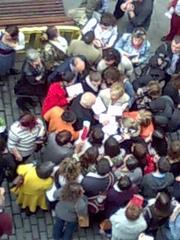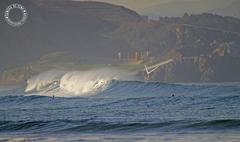
Llaranes Avilés Spain: Visiting Hours, Tickets, and Historical Sites Guide
Date: 04/07/2025
Introduction: Llaranes in Avilés, Spain — History and Significance
Nestled in the municipality of Avilés, Asturias, Llaranes stands as a living testament to Spain’s industrial transformation in the 20th century. Once a small rural parish with ancient roots — evidenced by Neolithic tools and Roman coins — Llaranes underwent a dramatic evolution during the post-war industrial boom. The establishment of the state-owned steel company ENSIDESA in the 1950s catalyzed the development of Llaranes as a purpose-built residential district for steelworkers and their families, embodying the progressive urban ideals of the garden city movement (Enciclopedia Asturiana; Patrimoniu Industrial).
Today, Llaranes invites visitors to explore its blend of pre-Romanesque heritage, innovative mid-century urbanism, and vibrant community traditions. Notable landmarks include the San Lorenzo de Cortina chapel (with its rare 9th-century pre-Romanesque window) and the Iglesia Parroquial de Santa Bárbara, renowned for its Renaissance altarpiece and expansive frescoes (Patrimoniu Industrial). The neighborhood’s Plaza Mayor and company-era worker housing remain emblematic of Francoist-era industrial urbanism, earning Llaranes international recognition among industrial heritage sites.
Beyond its historical sites, Llaranes is a thriving community, famous for annual festivals, cider celebrations, and active social associations. Its accessible, flat layout and reliable public transport make it easy to visit, while amenities and guided tours are available seasonally (Avilés Comarca Info; Travel Buddies). Whether you’re drawn by architecture, cultural events, or the neighborhood’s compelling story, Llaranes provides an enriching Asturian experience.
For updated visitor information, guided tour options, and interactive maps, consult the Official Avilés Tourism Website.
Contents
- Introduction and Historical Context
- Visiting Llaranes: Hours, Tickets, and Accessibility
- Architectural and Urban Highlights
- Festivals and Community Life
- Practical Visitor Information and Travel Tips
- Local Attractions and Accommodation
- Frequently Asked Questions (FAQ)
- References
Historical Overview
Early Origins and Pre-Industrial Heritage
Llaranes’ origins date back to ancient times, with archaeological discoveries — such as Neolithic tools and Roman coins — confirming early habitation (Enciclopedia Asturiana). The area’s rural parish was historically centered around the San Lorenzo de Cortina chapel, notable for its preserved 9th-century pre-Romanesque window.
During the Middle Ages, Llaranes remained a small agricultural enclave near the fortified town and port of Avilés. Its annexation in the 17th century further integrated Llaranes into the city’s urban and social fabric.
Industrial Revolution and Modern Development
The defining transformation of Llaranes occurred in the 1950s, following the establishment of ENSIDESA. Architects Juan Manuel Cárdenas and Francisco Goicoechea Agustí designed the neighborhood as a model workers’ village, complete with housing, schools, medical facilities, a church, and communal spaces. At its peak, Llaranes housed around 8,000 residents and became an exemplary case of industrial urbanism (Patrimoniu Industrial; Academia Lab).
Visiting Llaranes: Hours, Tickets, and Accessibility
- Neighborhood Access: Llaranes is an open, residential area accessible year-round at no charge.
- Key Sites Opening Hours:
- Iglesia Parroquial de Santa Bárbara: Open during mass times and for special events. Check local schedules before visiting.
- San Lorenzo de Cortina Chapel: Access is limited; confirm opening hours in advance.
- Guided Tours:
- Offered through the Avilés tourist office and local cultural associations. Advance booking is recommended, especially during festivals (Official Avilés Tourism Website).
- Tickets:
- Exploration of the neighborhood and its main sites is free. Guided tours or special exhibitions may require a small fee (usually €3–€7).
- Accessibility:
- Llaranes’ flat terrain and paved streets make it accessible for visitors with mobility challenges, though some historic buildings may have limited access.
Architectural and Urban Highlights
- Iglesia Parroquial de Santa Bárbara:
The neighborhood’s spiritual heart, featuring a 25-meter bell tower visible across Avilés. The luminous interior is famed for Javier Clavo’s frescoes and a Renaissance altarpiece (Patrimoniu Industrial). - San Lorenzo de Cortina Chapel:
Houses a rare pre-Romanesque window and stands as a testament to Llaranes’ ancient heritage. - Plaza Mayor:
The central social and commercial hub, reflecting the conservative postwar style of the town’s origins. - Company-Era Worker Housing:
Distinctive slate-roofed residences (pabellones and pantallas) mirror ENSIDESA’s social hierarchy and encapsulate the ideals of mid-20th-century industrial urban planning.
Festivals and Community Life
Llaranes is renowned for its vibrant social traditions and annual celebrations:
- San Lorenzo Festival (early August):
Honors the original patron saint with processions, music, communal meals, and games. - Santa Bárbara Feast (early December):
Celebrates the neighborhood’s dual identity as parish and industrial community. - Sidra Asgaya Festival:
Organized by Cofella, this event celebrates Asturian cider culture with tastings and contests (lne.es).
Llaranes’ active social associations, such as Escontra’l Raigañu (folklore), Alfoz de Gauzón Study Center (regional history), and MAVEA (ornithology), offer workshops and guided activities for visitors (Academia Lab).
Practical Visitor Information and Travel Tips
- Getting There:
Llaranes is about 3 km from Avilés city center and is accessible by bus (CTA network), taxi, or a 20-minute walk. Parking is available. - Nearby Attractions:
- Avilés Old Town: Medieval streets, the Sabugo neighborhood, and the Palacio Valdés Theatre.
- Oscar Niemeyer International Cultural Centre: Open Tuesday to Sunday, 10:00 AM–8:00 PM (Niemeyer Centre).
- Arnao Mine: Another key industrial heritage site nearby.
- Dining:
Local bars and cafés in Llaranes serve Asturian specialties; for a broader selection, visit central Avilés. Must-try dishes include fabada asturiana, cachopo, and fresh seafood. Sidra (cider) is the local drink of choice (Turispanish: Avilés Gastronomy). - Accommodation:
Most hotels and guesthouses are located in Avilés city center, just a short trip from Llaranes. Book in advance during festivals. - Climate:
Temperate maritime, with mild summers and cool, wet winters. Bring a rain jacket year-round (Spain.info: Weather). - Language:
Spanish is spoken; a few English phrases are helpful. - Safety:
Llaranes is safe and welcoming; use standard precautions.
Frequently Asked Questions (FAQ)
Q: Is there an entrance fee to visit Llaranes?
A: No, Llaranes is a residential neighborhood open to visitors free of charge.
Q: Are guided tours available in English?
A: Some tours are offered in English; check with the Avilés tourist office.
Q: Can I visit the San Lorenzo de Cortina chapel?
A: Access is limited; confirm opening hours locally.
Q: When is the best time to visit Llaranes?
A: Spring and early autumn offer pleasant weather and coincide with local festivals.
Q: Are there accommodations in Llaranes?
A: Most accommodations are in central Avilés, a short distance away.
References and Further Resources
- Enciclopedia Asturiana
- Patrimoniu Industrial: Llaranes
- Patrimoniu Industrial: Iglesia de Santa Bárbara
- Academia Lab: Llaranes
- Avilés Comarca Info
- Travel Buddies: Discover Avilés
- Turispanish: Avilés Gastronomy
- Spain Streets: Llaranes
- Spain.info: Customs Regulations
- lne.es article
Summary and Final Tips
Llaranes is a vital chapter in Asturias’ industrial story, blending ancient roots with innovative 20th-century urbanism and a lively community spirit. From the Iglesia Parroquial de Santa Bárbara and San Lorenzo de Cortina chapel to its festivals and dynamic social associations, Llaranes offers visitors an immersive experience in Asturian heritage (Enciclopedia Asturiana; Academia Lab).
Practical infrastructure, public transport, and visitor amenities make exploring the neighborhood easy. To get the most out of your visit, plan ahead, consult the Official Avilés Tourism Website, and consider using the Audiala app for real-time updates and guided experiences.
For further details on Avilés and its neighborhoods, including Llaranes, consult the official tourism website and local street guides.


